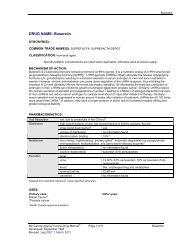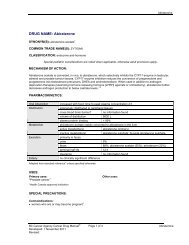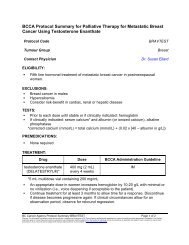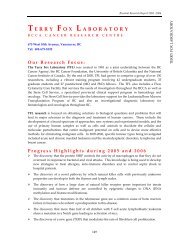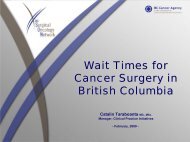CCSP manual - BC Cancer Agency
CCSP manual - BC Cancer Agency
CCSP manual - BC Cancer Agency
Create successful ePaper yourself
Turn your PDF publications into a flip-book with our unique Google optimized e-Paper software.
Limitations of Screening<br />
Screening Tests are not Diagnostic Tests<br />
Screening programs aim to reduce morbidity and<br />
mortality from cancer. Their goal per se is the<br />
“application of a relatively simple, inexpensive test<br />
to a large number of persons in order to classify<br />
them as likely, or unlikely, to have the cancer.” 1 The<br />
emphasis on likelihood underscores the limitations<br />
of screening (screening tests are not diagnostic<br />
tests). A person with an abnormal screening test<br />
does not have a definitive diagnosis until additional,<br />
more sophisticated diagnostic tests are completed.<br />
Screening test accuracy varies according to cancer<br />
site and individuals’ characteristics.<br />
Although most screening interpretations are<br />
accurate, it is inevitable that some individuals are<br />
identified as possibly having cancer when they do<br />
not (false positive screens) 2 , whereas others with<br />
disease are not identified (false negative screens).<br />
Facts About Screening and Cervical <strong>Cancer</strong><br />
The Papanicolaou (Pap) smear is a screening test<br />
for cervical squamous dysplasia and early invasive<br />
squamous carcinoma of the cervix. Glandular atypia<br />
can be detected in advanced pre-malignant lesions<br />
or in early adenocarcinomas. Some interesting facts<br />
about cervical cancer include:<br />
• In many countries where effective cervical<br />
screening is not available, the incidence rate of<br />
cervical cancer is high and increasing.<br />
• Most women diagnosed with cervical cancer in<br />
<strong>BC</strong> in the year 1999 had not had a Pap test in the<br />
past 3 years.<br />
• Despite the benefits of Pap testing, not all women<br />
take advantage of it.<br />
• The Pap smear is used to sample the<br />
asymptomatic woman who has a clinically normal<br />
appearing cervix. Those who are symptomatic<br />
require further investigation such as a biopsy,<br />
regardless of the result of the Pap smear test.<br />
Smears taken in the presence of symptoms are<br />
often unsatisfactory or have a higher false negative<br />
rate.<br />
• Cervical cancer behaves like a sexually transmitted<br />
disease. Human Papilloma Viruses (HPV), such<br />
as types 16, 18 and 45 are present in over 95% of<br />
cervical cancers. However, the majority of women<br />
who become infected with HPV, including those<br />
infected with high-risk subtypes, do not go on to<br />
develop invasive cervical cancer.<br />
• Other risk factors include:<br />
- commencement of sexual activity at a young age<br />
- multiple sexual partners or a partner who has<br />
had multiple sexual partners<br />
- history of other sexually transmitted diseases<br />
- immunosuppression or deficiency<br />
- smoking<br />
• Women who have never been sexually active<br />
have a low probability of developing cervical<br />
cancer. The health care professional should<br />
develop a rapport with these patients in order to<br />
feel confident that they have, in fact, never been<br />
sexually active. If there is any doubt, a Pap smear<br />
program should be initiated.<br />
• Evidence shows that women who have been<br />
screened regularly up to age 69 with negative<br />
smears will have a very low risk of developing<br />
cervical cancer.<br />
2<br />
1<br />
Cole P, Morrison AS: Basic issues in cancer screening. In Miller AB (Ed): Screening in <strong>Cancer</strong>. Geneva, International Union Against<br />
<strong>Cancer</strong>, 1978, page 7.<br />
2<br />
Miller, AB: Fundamentals of screening: In Screening for <strong>Cancer</strong>, Orlando, Academic Press, 1985, page 3.




